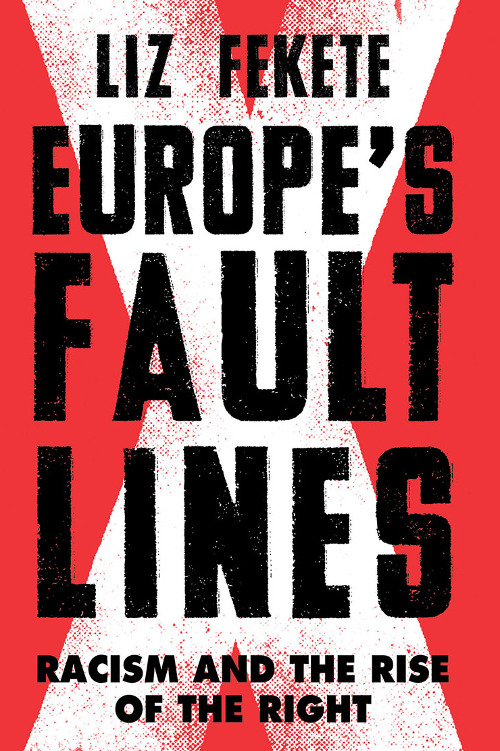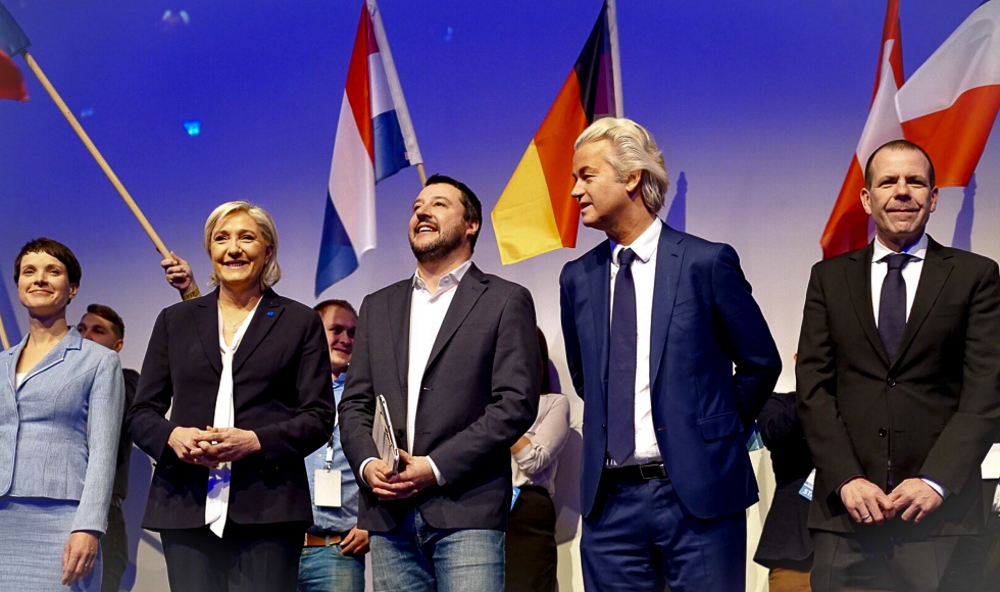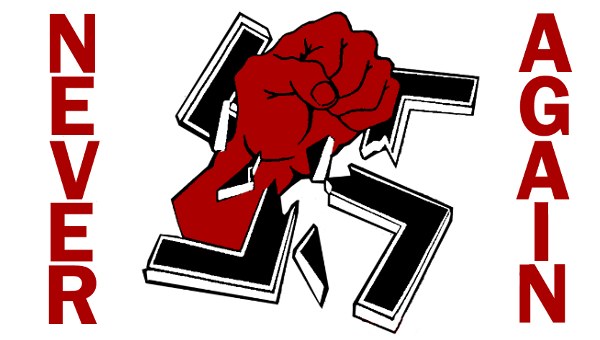Reading Europe’s Fault Lines
Notes from Europe as hard-Right populism enters Queen’s Park
The rapid marching of the right in electoral politics, intellectual circles, and on the streets has become an undeniable feature of European politics. Once believed to be relegated to the dustbin of history, the electoral success of figures such as Marine Le Pen in France, Matteo Salvini in Italy, and Viktor Orbán in Hungary has once again brought extreme-right forces to the centre of political life in Europe. How are we to make sense of this revengeful comeback of the right in the early 21st century? This is the question that Liz Fekete engages with in her new book, Europe’s Fault Lines: Racism and the Rise of the Right (Verso 2018).
 Fekete provides an accessible and stimulating discussion on the roles of the state, intellectuals, the media, and uneven development in the triumph of the right in our age of crisis and rage. In this regard, she “eschews a boxed-in, academic study of fascism, which almost invariably divorces the study of the far right from a simultaneous study of the state, and the study of fascism from popular and state racism” (p. 6). Director of the Institute of Race Relations in London (the UK) and the head of its European research programme, Fekete has worked on far-right politics, racism, and refugee rights across Europe for 30 years now. Her latest book builds upon and expands her earlier work, A Suitable Enemy: Racism, Migration and Islamophobia in Europe (2009), in which she looked at the institutionalization of xeno-racism (anti-foreign racism) and anti-Muslim racism within European immigration, asylum, and national security laws in the 2000s.
Fekete provides an accessible and stimulating discussion on the roles of the state, intellectuals, the media, and uneven development in the triumph of the right in our age of crisis and rage. In this regard, she “eschews a boxed-in, academic study of fascism, which almost invariably divorces the study of the far right from a simultaneous study of the state, and the study of fascism from popular and state racism” (p. 6). Director of the Institute of Race Relations in London (the UK) and the head of its European research programme, Fekete has worked on far-right politics, racism, and refugee rights across Europe for 30 years now. Her latest book builds upon and expands her earlier work, A Suitable Enemy: Racism, Migration and Islamophobia in Europe (2009), in which she looked at the institutionalization of xeno-racism (anti-foreign racism) and anti-Muslim racism within European immigration, asylum, and national security laws in the 2000s.
The Far Right – A Historical and Geographical Journey
Divided into four sections and eight chapters, Europe’s Fault Lines takes readers through a historical and geographical journey, moving across time and space, from our present conjuncture to those of the late 20th century and the aftermath of the WW I, from Poland, Hungary, Germany, the Netherlands, and Belgium to the UK, France, Spain, and Greece and onto the Scandinavian region. In covering these diverse geographies, Fekete shows readers that it is impossible to detach the current political popularity of the right in Europe from its feeding upon popular and state racism and the role of the state in facilitating and normalizing a shift to the right at a time of economic and legitimacy crises. States, as Fekete argues throughout the book, “can collude directly or indirectly, with the growth of fascism” (p. 8). In Europe today, “a racialized order, accompanied by a culture that makes ‘turning a blind eye’ possible, if not desirable, is the context in which collusion occurs, with the collusive state practices facilitating the actions of neo-Nazi parliamentaries or terror squads, and confounding investigations into their crimes, including arson, bomb attacks, and murder” (p. 9).
To delineate the diversity of forms, tactics, and strategies, Fekete categorizes the forces on the right into far-, extreme-, and hard-right. Extreme-right is a reference to electoral parties that are to the right of traditional conservative parties. While the extreme-right, by and large, plays within constitutional frameworks, it also systematically aims to push further the liberal tolerance thresholds of public utterances of racist language and rhetoric. Their major difference with the far-right is their lack of direct involvement in street politics and violence. Hard-right in turn denotes the new patterns that emerge when various, seemingly discrete, electoral platforms come together on the right, and, as a means of distinguishing the ideology of parliamentary hard-right from the violent interventions of the extra-parliamentary ultra-right.
The first section, “The State of Play,” gives readers a view of the on-the-ground making of what appears as sudden bursts of the ultra-right forces into public life in Europe in recent years – the mass-killings of Anders Behring Breivik in Norway, the surge of the Golden Dawn militias in Greece, the mass-rallies of Pegida in Germany, etc. Racist mobilization from below, most often around local everyday issues born from within the contradictions of neoliberalization and uneven development, and an increasing collusion with the forces of ‘law and order’ – in particular private security forces – have been key to the violent muscle flexing of the ultra-right powers.
The emboldened public presence of the ultra-right, Fekete argues, has also been in a dialectical relation with the electoral success of the extreme-right at various scales, from the municipal to the EU levels. The electoral achievements of parties such as the Front National (France), Jobbik (Hungary), Sweden Democrats (Sweden), the Party of Freedom (the Netherlands), and Lega Nord (Italy), did not just mean representative seats, but more importantly access to generous amount of state funding, which in turn allowed for establishing power-bases in municipal and regional governments across Europe. Yet, how did the forces of extreme-right, which were systematically isolated by European mainstream political parties for decades, mange to win elections in the first place?
To answer this question, Fekete takes readers to the conjuncture of the 1990s, in the aftermath of the collapse of the Soviet Union, the violent break-up of the former Yugoslavia, and the aggressive reign of neoliberalization as the ideological mantra of mainstream parties in power, from conservatives to socialists. The 1980s feel-good politics of cordon sanitaire (still at play in Belgium, for example) conveniently camouflaged the gradual formation of political and ideological convergences among mainstream political parties and the then in-the-process-of-rejuvenation extreme-right forces. Xeno-racism is the focal point of these convergences. Fekete identifies four interrelated convergences, from the moral panics around the so-called refugee crisis in the 1980s and the 1990s, to attacks on the employment and social rights of migrants, the anti-immigrant and anti-Muslim rhetoric of the ‘war on terror’, and, the increasing convergence between extreme-right and the military and security forces (manifested, for example, in the voting patterns of police and security forces and the willful blind eye of state security forces on the activities of the far-Right groups).
Since the late 20th century, the extreme-right has been able to rejuvenate its forces and rebrand old ideologies inherited from cultural conservative, authoritarian and colonial traditions in Europe. How this regeneration has taken place is the focus of the book’s second section, “The Structural Shift to the Right.” Here Fekete emphasizes the role of public intellectuals, academics, the media and the state in turning xeno-racism into common-sense. If in the post-WW II Europe references to racial superiority were hushed as taboo, cultural claims substituted for the civilizational logic of racial superiority. Since the 1970s, increasing number of New Right intellectuals have patiently but persistently brought a cultural revolution to the right by reframing its racist ideology with appeals to cultural difference, way of life, and human nature.
The ‘war on terror’ provided an unending fuel for the New Right’s cultural revolution. In the last two decades we have been witnessed to the birth of a whole xeno-racist literary genre, written in confessional, nostalgic, and popular style, mourning and warning about the invasion of Europe by immigrants. This popular xeno-racist genre enjoys a high-level of respectability not least because many on the left of the political spectrum have gradually joined the voices of the New Right to protect an imagined Europe of civility and culture. Fekete walks readers through some of this popular literature and shows the ideological debt of its authors to the likes of Oswald Spengler and Carl Schmitt who were influential in cultivating the seeds of fascism in the period after the WW I.
The popular success of the xeno-racist literary genre has to do, in part, with its mythical ethno-nationalism that taps into the insecurities of an ever-greater fractions of society at the time of the dismantling of the welfare state, economic crises, and the rapid rise of precarity. It has also greatly benefited, as Fekete nicely demonstrates, from a fertile ground produced by the mainstream media and politicians around the ‘enemy aliens’ breathing and breeding among ‘us’. As sensationalism has become a selling point for the media and a vote-grabbing strategy for politicians, the demonized figure of the foreign criminal has occupied European popular, political, and legal imaginations. Hordes of academics, from legal theorists to criminologists, have rushed to rationalize the xeno-racist ideology that conceives of non-white migrants as inherently criminal and thus deserving a double punishment of imprisonment and deportation.

In the next section, “Fallout,” Fekete situates the growth and popular appeal of the right and its ethno-nationalism in the context of uneven development within the EU and the exploitative core-periphery relations of the Eurozone. Starting from Europe’s eastern territories, where neoliberal strategies of democratization and integration into the Eurozone have devastated the economic structures and social life of former Communist countries, Fekete shows how hard-right forces have flourished from within the ruins of the broken promises of a better future. Extreme-right parties in Hungary and Poland, for example, have successfully capitalized on the disciplinary power of religion (Catholicism and Calvinism) and an authoritarian ethnic nationalism infused with 19th-century Darwinism, anti-Roma and anti-immigrant racisms. The effects of uneven development are not limited to the former Communist corners of Europe. Readers also get an exposé of the southern peripheries of Europe, where legacies of dictatorship have become the backbone of the extreme-right forces. Fekete also takes readers to the peripheries in the core, in the deindustrialized, depopulated, stagnated regions in Austria, Germany, France and the UK, where vökkisch populism and neo-colonial nativism have become the mantras of emboldened forces of extreme- and far-right.
What has been the reaction of the EU and member states to this upsurge of the forces of the right in Europe? In the second half of “The Fallout,” Fekete introduces readers to the fascinating (albeit disturbing) world of the EU counter-extremism strategies targeting far-right forces – known as Exit programmes. Strategies that were first pioneered in Scandinavia in the 1990s and then exported to Germany in 1998. Built upon failed gang-prevention strategies and run by former neo-Nazis, the ideological underpinnings of Exit programmes have culturalized and depoliticized the popularity of far-right ideologies and politics. The premise of the Exit programme is that involvement in far-right groups has to do with the “cultural grievances of white working-class men.” White grievances are in turn understood as an emotional and psychological reaction to the state’s multicultural polices, failed integration and unlimited immigration. The result is that as ‘immigrants’ and anti-racist politics and activism are now targeted as problems a whole industry is produced around an ‘expert class’ of former neo-Nazis erasing the political and ideological dimensions of the shift to the right. Tommy Robinson, the former leader of The English Defence League, whose 15,000 strong supporters took to the streets of London in June 2018, was one of the celebrity participants of the Exit programme.
In the final section, “Securitization and Resistance,” Fekete first takes on the myth of refugees as a burden for Europe. Her detailed account shows how a mixture of externalizing the responsibility for refugees, militarizing the borders, securitizing migration, and privatizing security has produced an extremely profitable asylum market. The long chain of beneficiaries of this inhumane market, in which people are treated as pure commodities or units of exchange to be shifted like parcels, include a diversity of forces, from multinational companies, global banks, and private security companies, to architects, designers, and constructors of detention and processing centers, and onto global management consultancy firms, digital technology companies, and Western Union. Fekete closes her book by underlining the need for more systematic, multi-dimensional forms of resistance to the fast marching of the right, countering the right’s ideology at the local level, while scrutinizing the complicity of the state and the mirage of nationalism as a solution to the contradictions of neoliberal capitalism.
Europe’s Fault Lines is a wealth of resource on one of the most disturbing aspects of our age of rage. Like any ambitious work, the book has it strengths and weaknesses. Its accessible language, detailed analysis, and constant travels across time and geography not only has made Europe’s Fault Lines stand out, but also has opened it up to a broad and diverse audience. There is, however, a conflation of fascism, authoritarianism and right populism in Fekete’s narrative. While from the outset, she nicely defines her conception of the right, readers never get the same treatment when it comes to fascism and authoritarianism, which at times makes it confusing where and whether are differences among fascist, authoritarian and ultra-right politics. Fekete’s stimulating narrative also opens up new questions and calls for more research and reflection, in particular on the links among urban uneven development, racialized and spatial segregation, and the rise of the right in European cities, at the time that non-white working-class neighbourhoods, suburban and inner-city, have come under attack as bastions of ‘terrorism’ and ‘radicalization’.
Confronting the Far Right
While North America is an ocean apart from Europe, with its own specific histories of settler colonialism, capitalism, nationalism, imperialism and racism, there is a lot to take away from Europe’s Fault Lines. The presidency of Donald Trump in the United States, the premiership of Doug Ford in Ontario, and the public-relations campaign of the former Canadian Conservative Prime Minister, Stephen Harper, are all wake-up calls that the rapid marching of the right is not limited to the birth place of capitalism, colonialism, fascism and Nazism. While electoral politics neither define nor determine the messy and complex trenches of politics, they regulate the balance of forces within the state and affect the on-the-ground struggles for social justice and democratic politics. For those of us in Ontario, now under the governing power of hard-right populism for at least the next four years, Fekete’s book is a forceful reminder to avoid reading politics off of electoral maps as it became fashionable in the aftermath of the mayoralty of Rob Ford in Toronto (2010-2014) (see Kipfer and Saberi 2010, 2014).
Rather than sinking into an environmentally deterministic politics of blaming the inherent conservatism and short-sightedness of those, working-class, non-white, and otherwise, who live in the scattered suburban, exurban, and rural landscapes of Southern Ontario, Europe’s Fault Lines invites us to grapple with the forces that have made those maps possible. These include: the extreme uneven development across Ontario; the effects of three-decades of abashed neoliberal restructuring; the deepening forms of geographical concentration and segregation of non-white poverty, white-poverty, non-white wealth and white wealth; the imperialist and neoliberal tenets of Canadian immigration system; the everyday contradictions of liberal multiculturalism in a province (and country) where structural racism strongly defines the politics of housing, education, labour and policing; the normalization of figures such as Ezra Levant and Jordan Peterson; and last but not least, the fragmented and sectarian spaces and politics of the left. •
Sources:
- Kipfer, Stefan and Parastou Saberi. “From ‘revolution’ to farce? Hard-right populism in the making of Toronto,” Studies in Political Economy Vol 93, Spring 2014: 93-100.
- Saberi, Parastou and Stefan Kipfer. “Rob Ford in Toronto: Why the ascendency of hard-right populism in the 2010 mayoral election?,” New Socialist, Nov. 2010.





